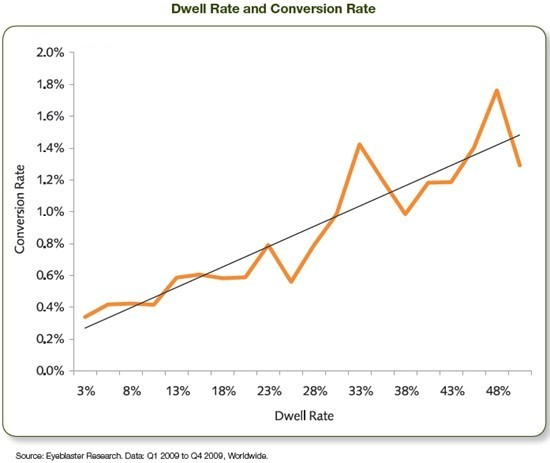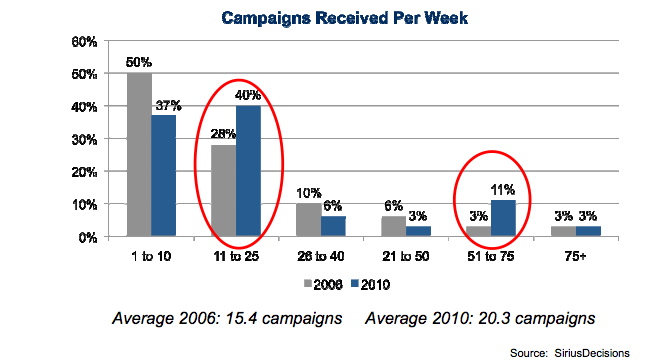Response Rates Under Pressure; Experts Offer Best Practice Tips
- Published in Feature Articles
 With the number of campaigns hitting prospects increasing by 32% over the last four years, according to SiriusDecisions’ 2010 BtoB Buyer’s Survey, climbing from 15.4 per week to 20.3 per week, there is growing pressure for marketers to create messaging that stands out and drives conversions.
With the number of campaigns hitting prospects increasing by 32% over the last four years, according to SiriusDecisions’ 2010 BtoB Buyer’s Survey, climbing from 15.4 per week to 20.3 per week, there is growing pressure for marketers to create messaging that stands out and drives conversions.
SiriusDecisions benchmark data pulled from hundreds of BtoB companies shows that average response rates range between 2% and 5%. Megan Heuer, Service Director, Marketing Operations Strategies, at SiriusDecisions, pointed out that best-in-class companies achieve higher response rates with “better targeting and relevant content aligned with the buyer’s journey.”
In addition, Heuer noted that companies are monitoring response rates for existing customers compared to “net-new” prospects, rather than looking at an average that can bury the differences between those groups that are meaningful to achieving better marketing performance.
The Direct Marketing Association (DMA) found that response rates for BtoB companies were 4.28% in its “2010 Response Rate Report.” Lead generation mailings were a little bit higher at 4.74%. DMA Research Manager Yory Wurmser said the numbers vary greatly by industry. “A financial services company mailing credit card offers would be thrilled with a 0.7% response rate,” he said, noting that the profit margin has a large weight on the rate. [Note: These figures are all for direct mail. DMA has analogous numbers for email, telephone, Internet display, search and other media.]
 Building Around Buyers
Building Around Buyers
Segmentation is not a new idea, but experts urge marketers to think about the buyer’s journey to optimize response rates, not necessarily the buyer demographics alone. “This means knowing who actually buys from you today, the roles in those accounts who are part of the buying process, and how their issues, needs and preferences are different,” Heuer said.
While it’s imperative for marketers to consider all facets of their buyers’ persona and needs, it’s equally significant to explore the tools and technologies available to maximize the understanding of buyers for a comprehensive view of who to target. “With web analytics and other tools, it is far easier [than before] to get good data on who is interested in your products/services, and with better analytic packages, it’s much easier to figure out the key factors that determine what type of person is most likely to buy from you,” said the DMA’s Wurmser. “With better focus, you can buy the right lists and weed out names that are least likely to produce response. So, you can get a better response while sending out fewer messages, i.e., increase revenue while cutting costs.”
Although buyer personas can help marketers deliver more relevant content to prospects, marketers don’t always have a comprehensive understanding of the target audience. “Run a report on the titles of the primary contacts at your closed/won opportunities,” said Jason Stewart, Demand Generation Leader, Demandbase.” You might be surprised by what you find, especially with regard to the seniority level of your contacts. Have you been targeting VPs when you should be talking to Directors? Another thing our clients inevitably discover is that they have a bigger footprint in some industries than they expected. They look at the industry breakdown of the traffic to their high-value pages and always find a previously undiscovered audience they haven’t been pursuing as aggressively as they should.”
To Gate or Not to Gate
While registration pages are a fundamental part of the demand generation process, experts agree that gated content is not always the only approach. “If your goal is to amass a mailing list, [view it as in exchange for the download — marketers collect names and pertinent contact information via some sort of registration roadblock],” said Ann Handley, Chief Content Officer, MarketingProfs. “You’ll get fewer downloads than you would with losing control, so the number of folks you’ll reach will be smaller, of course. You won’t benefit from any social media sharing love, but you will wind up with a list of people to market to. On the flipside, for some marketing campaigns, it might be more suitable to ‘lose control’ of your marketing and allow ideas to spread virally, rather than hiding them behind a registration page.”
SiriusDecisions’ Heuer added that ungated content can help engage visitors early in the sales cycle, thus increasing response rates. “But the presence or absence of a gate is not always the only issue — marketers need to take a good look at the forms they use and the conversion rate versus the volume of visitors who get to the form to assess, whether a form itself is hurting conversions,” she said. “Many times, the form is too long and not optimized to get the right people to complete it, so all those hard-won click-throughs are wasted.”
While the decision to gate content is reliant upon a marketer’s desired outcome, consider the stages and phases of the content. “You need to get the word out, educate as many people as possible about the problems you address and possible implications of those problems,” Stewart said. “If they understand this, then they become a good prospect for you and will be more willing to share their personal information in exchange for information on how to solve their problems. And they will be a better, more qualified lead…Track the accounts hitting the pages where ungated content lives, and then remarket to them to drive them through the funnel.”
Think Outside the Inbox
Interactivity is no longer a novelty. Marketers need to tap all the web 2.0 tools available. “Social media, landing pages, SEM, SEO, analytics — all have opportunities for measuring the results of your segmentation efforts,” Handley said. She added that once profitable segments can be identified, marketers can view behavior more comprehensively.
“Marketing campaigns that actively engage consumers online for longer periods of time — by enticing them to "dwell" — are more likely to generate high conversion rates and are three times more effective at driving brand-related web searches, according to a study by Eyeblaster,” she said. “In an era filled with more messages, products, and services than ever before, you have to stand out. It might sound trite to say you need to cut through the clutter, but you do. It's easy for your prospects to tune out your messages.”
Demandbase’s Stewart emphasized the importance of clicks over opens in email campaigns. “When you do A/B testing on a subject line, select the one that drive the most clicks, not opens,” he said. “An attention-grabbing subject line might drive opens, but a more accurate subject line might actually be the one that creates the response you are looking for.”

